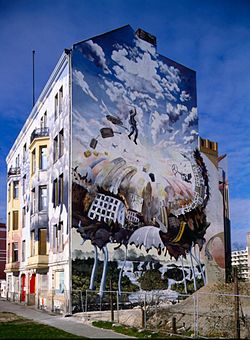Building in Berlin, Germany
| Tommy Weisbecker Haus | |
|---|---|
 Mural in 1990s Mural in 1990s | |
| General information | |
| Classification | Housing project Self-managed social centre |
| Address | Wilhelmstraße 9 |
| Town or city | Berlin |
| Country | Germany |
| Coordinates | 52°30′28″N 13°25′34″E / 52.50778°N 13.42611°E / 52.50778; 13.42611 |
| Opened | Squatted 1973 |
| Website | |
| tommyhaus | |
The Tommy Weisbecker Haus is a housing co-operative and self-managed social centre based in an apartment block in Kreuzberg, Berlin, Germany. It was established in 1973 when young people squatted it as an autonomous youth homeless shelter. Quickly legalized, it became a housing project and signed a new 30-year lease in 2013.
History
The house was occupied in March 1973 and was one of the first squats in Berlin, alongside the Georg-von-Rauch-Haus. It is named after Tommy Weissbecker, a young anarchist who was involved in the 2 June Movement and was shot dead by police on 2 March 1972. The original plan was for the building to house homeless young people and it was quickly legalized as a shelter project. This status entitled the group to financial support and when the Senate of Berlin offered an amount the former squatters considered to be too low they organised a mass shoplifting protest.
After the kidnapping of Peter Lorenz in 1975, the house was raided owing to its perceived connection to the 2 June Movement. In 1981, the house was renovated as part of the International Building Exhibition Berlin.
The exterior of the house is covered by murals which were painted in 1989. They have become a celebrated example of street art in Berlin and a graffiti hall of fame.
Recent events
In 2013, the house celebrated its fortieth anniversary and signed a new rental contract for another thirty years. It houses around 40 people and keeps four rooms available for homeless youths. On the groundfloor there is a self-managed social centre called Café Linie 1.
References
- Vasudevan, Alex (2015). Metropolitan Preoccupations: The Spatial Politics of Squatting in Berlin. John Wiley & Sons. ISBN 9781118750599.
- Sedlmaier, Alexander (2014). "Urban Space: The Squatting Movement". Consumption and Violence. University of Michigan Press. pp. 205–232. doi:10.2307/j.ctv3znzm0.9. ISBN 978-0-472-11941-7. JSTOR j.ctv3znzm0.9. S2CID 168989237.
- ^ Siepmann, Edith (2009). "Kreuzberger Chronik: Das Tommy Weisbecker-Haus – Sie lesen das Original! aus Berlin-Kreuzberg". Kreuzberger Chronik. No. 104. Retrieved 20 February 2021.
- Pugh, Emily (2015). ""You Are Now Entering Occupied Berlin': Architecture and Rehab-Squatting in West Berlin"". Centropa. 14 (2).
- Lovell, Sophie (9 March 2017). Berlin in Fifty Design Icons. Octopus. p. 66. ISBN 978-1-84091-757-4.
- Stein, Eliot (20 September 2016). "12 Reasons Berlin Is the World's Best Street Art Spot". Condé Nast Traveler. Retrieved 20 February 2021.
- Gegenheimer, Martin; Lüber, Klaus (2017). "Berlin Not for Sale". Goethe Institut. Retrieved 20 February 2021.
- Tudge, Robin (9 July 2013). "Letter from Germany: Tommy's house". The Guardian. Retrieved 20 February 2021.